We All Overcome
“Mental health problems are more common than heart disease, lung disease and cancer combined.”
– National Institute of Mental Health
Key: Mental health is on a continuum like physical health, and should be accepted that way instead of an abnormal condition.
Living it: Become aware of your own mental health needs and signals while raising awareness and acceptance by showing it’s a normal part of life.
Clinical Concept: Eliminating the impact of stigma on personal and cultural mental fitness.
You know how it goes. You take care of yourself, take vitamins, wash your hands and sanitize but still the feeling starts as a tickle in your throat, or a tightness in your sinuses and then—ugh!—you’re sick. Maybe you spend a day or so denying it as your coworkers tell you to go home because you’re looking rough. You tough it out for a bit, take your favorite over-the-counter remedy and go to bed early; you know how to handle it, you think. Finally, the next day, you face reality, call out of work and see the doctor. Hey, it’s nobody’s fault, it’s just a cold. In a few days you’re up and around again; it’s better than winding up in the hospital.
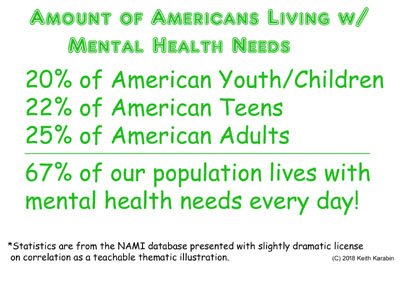 But what if that wasn’t how it goes? What if you didn’t even know how to take care of yourself or to notice the first signs? What if you spent days or weeks ignoring or denying it and your coworkers never said a word? Well, to you, at least. What if the only remedy you knew of was an extra glass of wine, more video games, cookies or serving of fries? What if your first real understanding of everyone’s mental health needs was when you found yourself in a hospital?
But what if that wasn’t how it goes? What if you didn’t even know how to take care of yourself or to notice the first signs? What if you spent days or weeks ignoring or denying it and your coworkers never said a word? Well, to you, at least. What if the only remedy you knew of was an extra glass of wine, more video games, cookies or serving of fries? What if your first real understanding of everyone’s mental health needs was when you found yourself in a hospital?
“The statistics are staggering” wrote Wendy Ward of the Youth Mental Health Project. “One in five children in the U.S. has a diagnosable mental health condition, and yet, less than 20 percent of youth receive the treatment they need to live healthy, productive lives” (YMHP, 2018). National Institute of Mental Health (NIMH) research also shows “that mental illnesses are common in the United States, affecting tens of millions of people each year” but a fraction of that number actually get help (2018). Experts vary in their findings but a study of “90,000 participants from across the globe” by King’s College London found that “up to 75 percent of Americans and Europeans don’t seek the help they need because…the profound reluctance to be a ‘mental health patient’ means people will put off seeing a doctor for months, years, or even at all, which in turn delays their recovery” (Krans, 2014).
I’ve known both sides of the continuum for years as a therapist at a rehab, a residential treatment facility, inpatient hospital, and now as a clinician in the outpatient world helping kids and families who are just admitting they have a need navigate toward health for the first time. Also, I’ve known it as a person because, though I don’t have a diagnosed mental illness, I am a human. I get sad, I get nervous—sometimes very nervous—and I’ve always struggled with my weight which I’m certain is a negative coping skill for stress. Thus, I’ve always felt that much of the stigma about being a “mental health patient” is counterproductive and most importantly a sort of social self-deception.
Check out the chart above, 67% of our total population have a treatable mental health issue and that’s not including those who’ve had an issue at one point and were able to overcome “over the counter.” Or includes those who get sad, nervous, drink, shop, gamble or eat too much for emotional reasons. We all overcome stuff every day.
I knew this in my core and I sought out data to verify it. 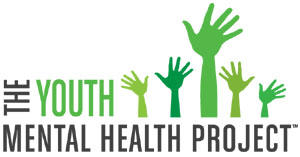 That brought me to the Youth Mental Health Project which is spearheaded by two mom’s with children who have mental health needs. “Given our combined experiences,” Ward wrote, “we knew that, just like physical health, mental health lies on a continuum and includes all states of health, from wellness to illness” (YMHP, 2018).
That brought me to the Youth Mental Health Project which is spearheaded by two mom’s with children who have mental health needs. “Given our combined experiences,” Ward wrote, “we knew that, just like physical health, mental health lies on a continuum and includes all states of health, from wellness to illness” (YMHP, 2018).
That statement floored me when I read it. Yes. That was what my heart was saying, and here were people who already had an organization about it! I was eager to help. So I waited for my birthday and took a whack at one of those Facebook birthday fundraisers which I thought were cool. I hoped to raise awareness and $50 for the cause. We raised nearly $400 for the Youth Mental Health Project and my heart soared at the generosity of my fine friends! Even more inspiring was that the overwhelming theme on my friends list was one of support and agreement that perhaps the time had come to take a deep breath and let down our facades a bit. To say, yes, life is hard and we all struggle with getting out the door sometimes—but we can all overcome together.
Take Care, Be Aware
“We now have clear evidence that stigma has a toxic effect by preventing people seeking help for mental health problems.”
– Professor Graham Thornicroft,
Institute of Psychiatry at King’s College London
Wendy Ward and Randi Silverman of YMHP began raising awareness with screening a powerful film for parents and professionals. No, I won’t tell you which one, go to their site, it’s their story to share. But I will share what inspired them onward. “As we heard in the room that night, and every day since” Ward wrote, “a cycle of shame, blame, silence and misunderstanding prevents people from gaining knowledge about how to nurture children’s mental health or get help before mental health concerns become a crisis” (2018).
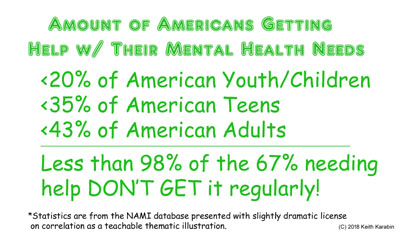 There is a cycle here. Check out the chart to the left. The percentage of Americans who could use help but are not getting it increases as we grow up. Parents who weren’t raised to think of mental and emotional health as something you nourish like physical health or practice like exercise don’t do it themselves or raise children who do. Our schools have come further with some curriculums in health class also dealing with emotions as early as elementary school but if the understanding isn’t part of our family norm it will be harder to root in our children. Thus, as they grow and see their friends have extreme and preventable episodes, kids have no framework to make sense of it except as this big, scary out-of-the-blue problem that happened to somebody else.
There is a cycle here. Check out the chart to the left. The percentage of Americans who could use help but are not getting it increases as we grow up. Parents who weren’t raised to think of mental and emotional health as something you nourish like physical health or practice like exercise don’t do it themselves or raise children who do. Our schools have come further with some curriculums in health class also dealing with emotions as early as elementary school but if the understanding isn’t part of our family norm it will be harder to root in our children. Thus, as they grow and see their friends have extreme and preventable episodes, kids have no framework to make sense of it except as this big, scary out-of-the-blue problem that happened to somebody else.
The same mental health issue could—and should—be seen the same as the difference between having the common cold or pneumonia. We all have hard days and illnesses, some of us just have different mental constitutions. But stigma and fear of being seen as “crazy” leads many of us to keep silent about our thoughts and feelings until they get too big to ignore in a crisis situation. Which is heartbreaking when the stress of life could have been managed with a mental fitness routine, then checking in with somebody and making a plan—maybe not even a counselor, just a friend or a web group. Stigma sucks.
King’s college found that “the main types of stigma facing those with a mental illness included the stigma associated with using mental health services, and shame or embarrassment…fear of disclosing their mental condition, concerns about confidentiality, wanting to handle their problems on their own, and not believing they need help.” Every one of those is preventable with a culture shift—but a culture shift is a gigantic thing.
Or is it? Could it be as simple as a Facebook post? Are we ready for a change as $50 becomes $400 in a blink? I believe I’m ready, and it starts with me. Stigma change begins as a personal change and “the hardest stigma to beat is the stigma that ‘looks back at us in the mirror’” said Natasha Tracy, a mental health writer and recipient of the 2014 Erasing the Stigma Leadership Award. She also happens to overcome bipolar disorder every day.
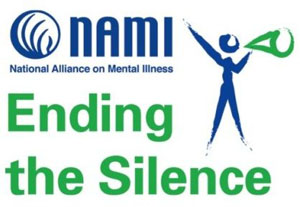 “Every one of us sees anti-mental illness images and ideas in society…” she said. “We must consciously be aware of our own thoughts and feelings towards our own mental health and fight to ensure that any unhealthy thoughts are replaced by more reasoned ones.” Tracy writes a “wildly popular” blog called Bipolar Burble. She advises others to see mental illness as just “a disease of the brain, just like pancreatitis or liver disease” and work towards their personal acceptance of their own mental health needs, which she acknowledges can take years (Kerns, 2014).
“Every one of us sees anti-mental illness images and ideas in society…” she said. “We must consciously be aware of our own thoughts and feelings towards our own mental health and fight to ensure that any unhealthy thoughts are replaced by more reasoned ones.” Tracy writes a “wildly popular” blog called Bipolar Burble. She advises others to see mental illness as just “a disease of the brain, just like pancreatitis or liver disease” and work towards their personal acceptance of their own mental health needs, which she acknowledges can take years (Kerns, 2014).
If you’re ready to go further than that, please get do get involved. If you share in the belief of the Youth Mental Health Project that “every child’s mental well-being needs to be nurtured, and that mental wellness and physical wellness should be equally prioritized” then seek out their site (YMHP, 2018). The NAMI Ending the Silence campaign is awesome for teens in schools. I’ve met some of their presenters—amazing overcomers! Check them out with a click. If you want, share this article. It’s a start.
Most of all, the first step toward a mental fitness attitude comes with caring; caring for yourself and caring about others—not just with big groups, but with small moments. Kindness and taking the risk to ask a co-worker, “Hey, how are you doing really?” sounds almost like too much to suggest as I write it. It might have been too much to read. And that’s the power of stigma right there. Let’s not allow it to stop us anymore. Let’s take care and be more aware. Let’s ask for help and overcome together.
__________________________________________________
Krans, B. (2014) Stigma Still a Major Hurdle in Getting People the Mental Health Care They Need. Healthline. Retrieved from: https://www.healthline.com/health-news/mental-health-treatment-hindered-by-stigma-030214#1
National Institute of Mental Health (2018) Statistics. Retrieved from: https://www.nimh.nih.gov/health/statistics/index.shtml
Ward, W. (2018) Our Story. Youth Mental Health Project. Retrieved from: http://ymhproject.org/our-story/


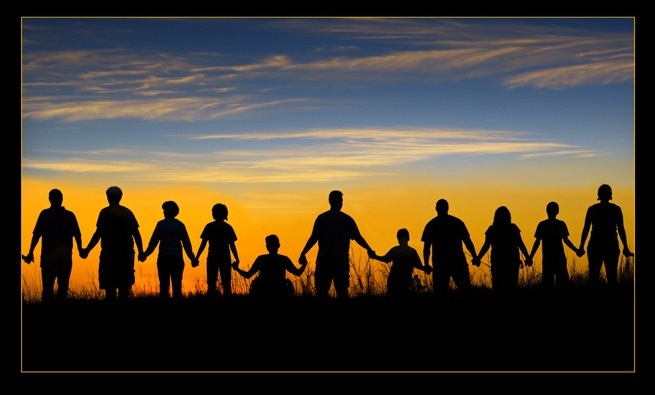
 Previous Post
Previous Post Next Post
Next Post